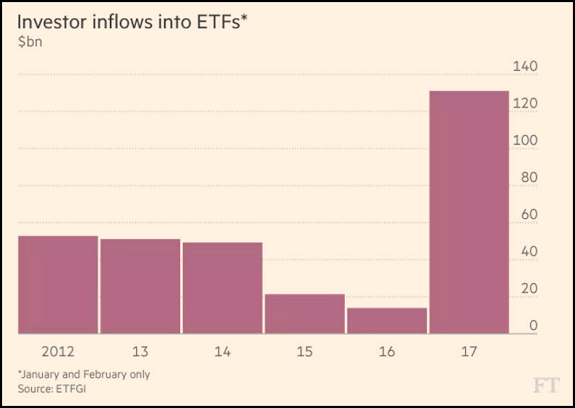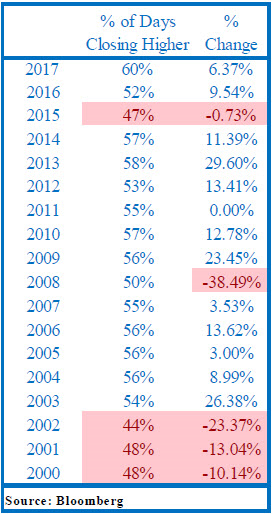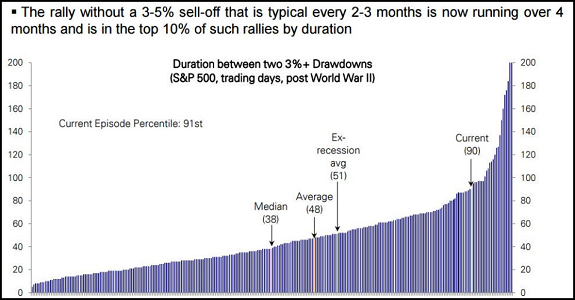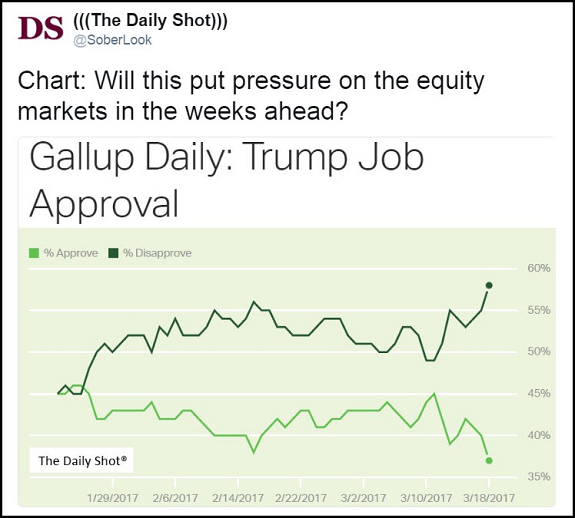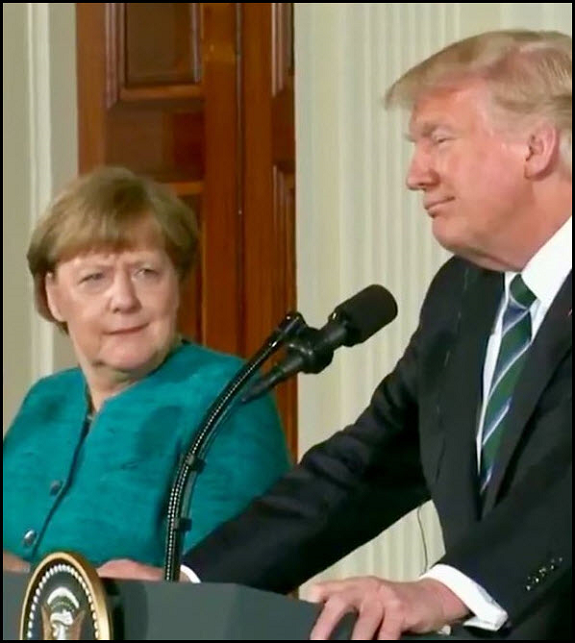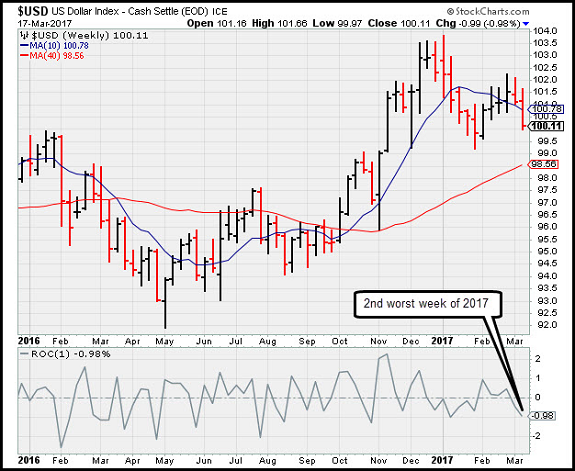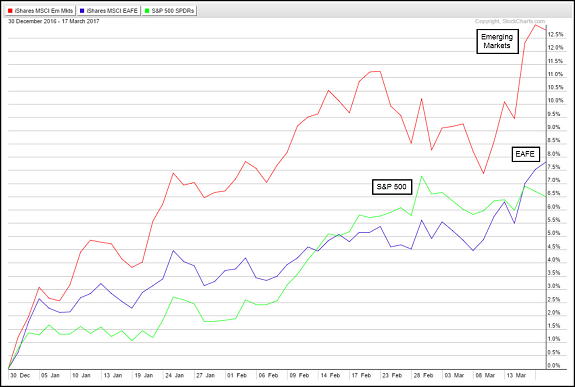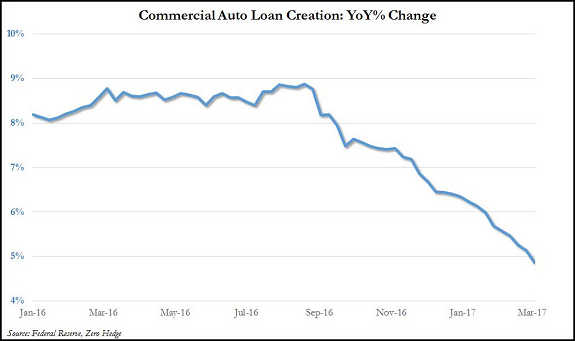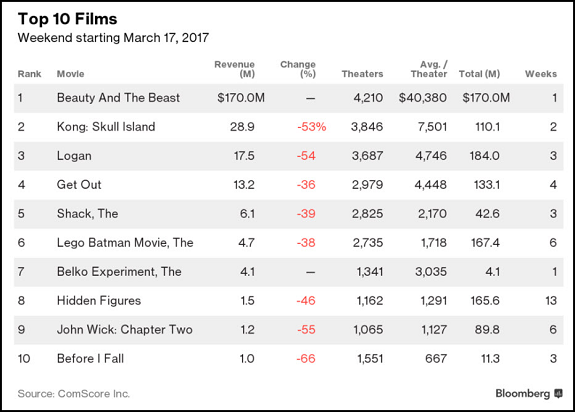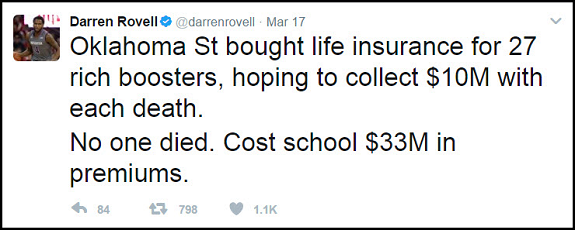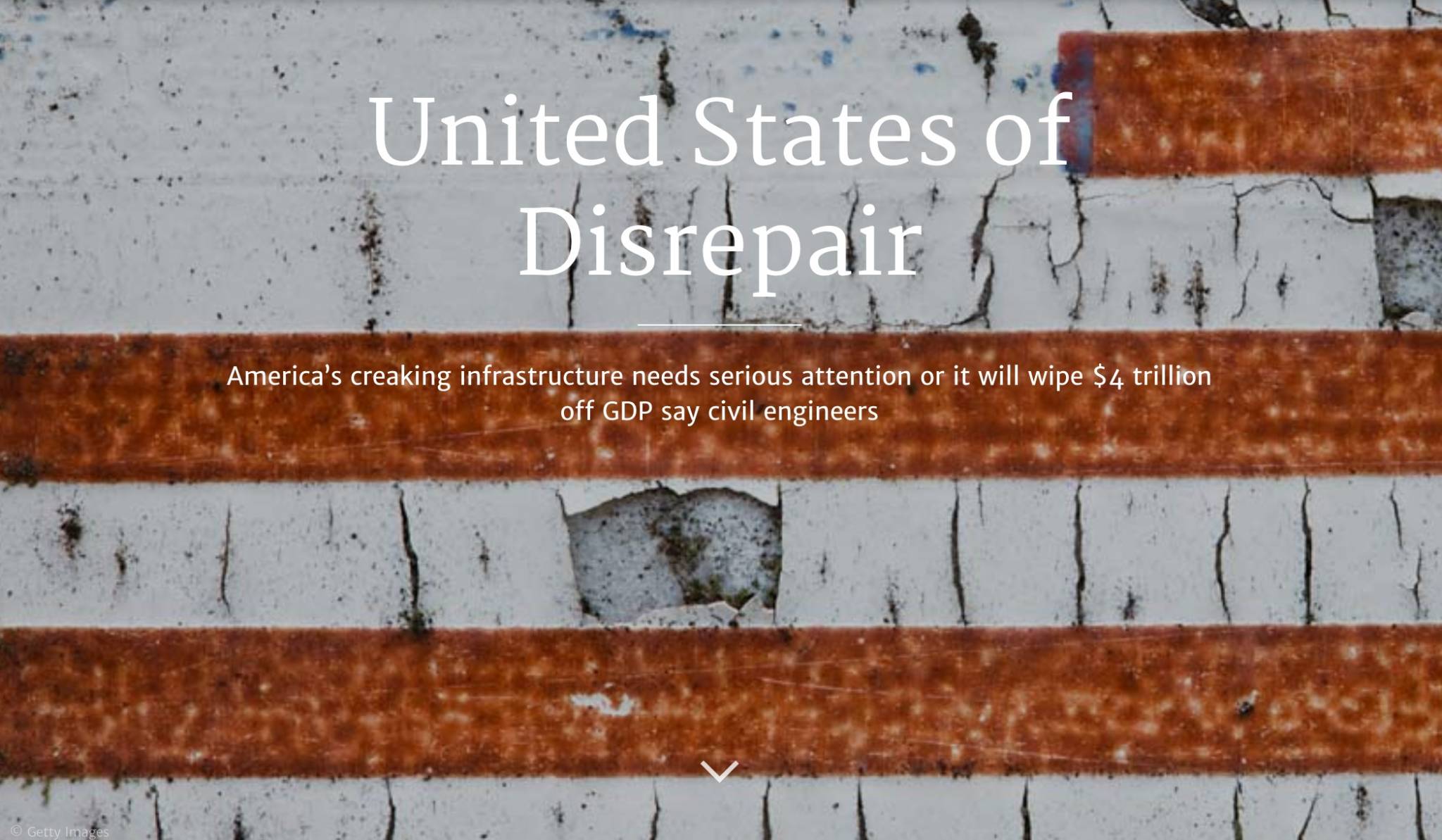by Blaine Rollins, CFA, 361 Capital
I know that I am not the only one feeling it. You can see the increasing risk in the markets and uglier action on the tape. Credit is seeing selling even as recession fears are distant. Bank stocks are rolling over even with the Fed raising interest rates. The U.S. dollar has begun to lose ground to most emerging market and developed nation currencies. The January and February economic data continues to look good. But as winter ends and the GOP enters its 2nd quarter of total control, this market needs something else to look forward to in order to reward the 10-15% move in the U.S. equity indexes since the election. We know how great things look in the rear-view mirror, but if we are shifting this American-made automobile into a higher gear, we want to see improvements in the windshield. The POTUS and the GOP need some wins before summer and the markets don’t want to see daily programs of government officials testifying in front of Congress. There is plenty of capital in the world looking for a home and if the U.S. Government wants to be the mud and grass in our gears, then that capital will head overseas. The emerging and developed international stock markets are clearly cheaper than the U.S. and all they need is a catalyst to cause a rise in the momentum for foreign investment. Maybe this peat bog in Washington will be enough to slow down the U.S. momentum and end the current record run of low volatility. So pull up your boots because this swamp may get deep.
Even as market momentum slows, investor flows into ETFs are accelerating at an alarming pace…
Exchange traded funds have attracted the biggest inflow of money in the first two months of the year on record, heightening concerns that ETF buying is fuelling an unsustainable price bubble in the US stock market. $131bn Inflows into ETFs in the first two months of 2017 Investors across the world ploughed $131bn into these index-tracking funds in the first two months of 2017, according to ETFGI, a London-based consultancy. This follows a record-breaking year in 2016, when ETF managers gathered more than $390bn in new cash. Donald Trump’s election as US president in November gave the already booming ETF business an extra shot in the arm. Encouraged by Mr Trump’s promises of sweeping tax cuts and large increases in infrastructure spending, investors have rushed into the US stock market via ETFs.
One has to look at the large inflows as contributing to the broad number of daily gains registered for 2017. This typically bodes well for future market performance…
As market participants know, this has been a very broad rally that has even provided dips to buy. The momentum has been nothing short of remarkable. Every so often, we like to check on the percentage of trading days closing positive for the year. We are nearly 3 months into the New Year and the percentage of days closing positive for the year is 60% (table below). This is a very strong momentum reading. Even more interesting is that the percentage of trading days closing positive since the election is also 60%. For some context, the highest annual reading going back to 2000 is 58%, registered in 2013 when the S&P 500 was up 29.6%.
(Jones Trading)
But while new money continues to buy stocks, investors are also bidding up the cost of insurance protection. “One foot on the brake and one on the gas”…
While the CBOE Volatility Index declined last week, the cost of protecting against large market swings has surpassed a peak hit following the Brexit vote, reaching a fresh all-time high. With the Federal Reserve raising borrowing costs and the political environment remaining uncertain, the CBOE SKEW Index climbed for five straight days, its longest streak since June 2016. The last time the gauge of out-of-the money S&P 500 Index options prices was as high relative to the volatility gauge, the VIX surged 65 percent in the next month.
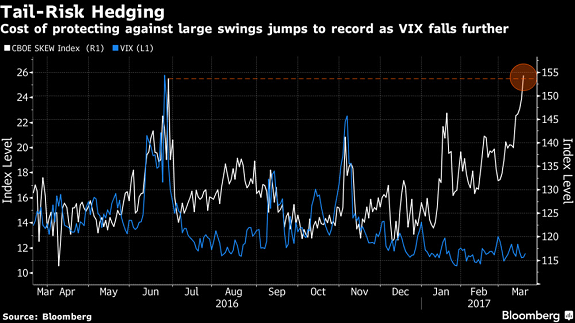
A big reason for the rising cost of protection is that the current rally is getting very long in the tooth…
@TheStalwart: Deutsche Bank offers another look at how long and durable this rally has become
Looking at Washington D.C., the POTUS approval polls are sliding as radical changes to government are being put on the table…
Reality bites…
“What you’re seeing now with the pullback is a feeling that the honeymoon is over, kind of an ‘uh, oh, things are going to take longer than we thought.’ ” (Mike O’Rourke, chief market strategist at JonesTrading Institutional Services)
Some analysts are growing skeptical that a tax cut will pass this year. Even with control of Congress, Republicans disagree on the architecture and details of plans to overhaul the tax code.
For instance, House Speaker Paul Ryan (R., Wis.) and Senate Majority Leader Mitch McConnell (R., Ky.) both say they don’t want the tax plan—with some caveats—to add to budget deficits. President Trump’s campaign plan didn’t meet that test and he is still promising huge tax cuts.
Republicans for procedural reasons also have put the tax bill behind the health-care overhaul, which is dividing lawmakers.
(WSJ)
Pressure on bank stocks accelerates…
Remember, banks want:
1) economic stimulus to increase loan growth
2) corporate income tax reform to help their tax rate and add certainty to customers
3) higher interest rates
4) reduction in banking regulation
And the timeline for these items is slipping into the muck.
I can’t wait to read the book on Friday’s meetings…
I am guessing that the Chancellor of Germany just made her final trip to the White House. At least for this decade.
(@TJSullivanLA)
Citigroup thinks that the U.S. dollar will have difficulty running through the swamp…
Citigroup has dimmed its expectations for the rally in the US dollar, saying it no longer expects the buck to reach parity with the euro over the next year.
The New York-based bank said that it now expects the euro to fall to $1.04 over the next six to 12 months, from a previous forecast of 98 cents. The common currency traded on Monday $1.076, but had closed as low as $1.0388 in late December. It sat at about $1.10 ahead of the election of Donald Trump in November last year.
Citi’s less bullish view for the dollar comes as the Trump administration finds itself lodged in a heated battle on Capitol Hill over its plans for replacing and repealing the Affordable Care Act. The struggle for the new administration may delay plans for business-friendly proposals, like tax cuts, regulatory reform and a large infrastructure spending programme, the bank said.
Of course, a breakdown in the U.S. dollar is great news for international equities, especially emerging markets which now have nearly double the YTD performance of U.S. equities…
Even Mexico has twice the return of the S&P 500 year to date which must please President Nieto…
(WSJ/Daily Shot)
Looking at economic data, U.S. workers are more confident to quit their jobs than in the last 15 years…
In January, the number of Americans quitting their jobs rose to a seasonally-adjusted total of 3.22 million, the highest number since February 2001. The quits rate rose in January to 2.2%.
And the housing market looks to be shifting into a higher gear…
Even I received an unsolicited letter last week from a buyer looking to move into my neighborhood.
(@bespokeinvest)
Now, if you are looking for trouble, keep an eye on loose auto lenders…
Increasing confirmation of worry in this stock chart by an important auto lender…
Hedged U.S. energy companies are drilling a hole in OPEC’s dreams of higher oil prices…
Hedged U.S. energy companies are drilling a hole in OPEC’s dreams of higher oil prices…OPEC’s worst enemy isn’t U.S. shale drillers. It’s the hedges propping them up.
American oil explorers who survived the worst of the 2014-2016 market rout are shrugging off the 14 percent slide in prices this year from a high of $55.24 to less than $48 a barrel Tuesday. The price would have to drop to the $30s or lower to dent the bottom line of many drillers now working U.S. shale fields, said Katherine Richard, the CEO of Warwick Energy Investment Group, which own stakes in more than 5,000 oil and natural gas wells.
That’s because many producers have already locked in future returns with financial contracts that guarantee the price of their oil for most of the rest of the decade. Such resilience poses a dilemma for countries that agreed to an OPEC-led production cut aimed at tightening supplies to raise prices and relieve their distressed national economies.
( Bloomberg )
A quick glance at the recent hot IPO of Snap…
Never a good sign when a high profile IPO loses most after-market buyers money.
Always interesting thoughts from Eric Peters…
Lithium: “Snap is obviously nuts,” said Lithium, hands-free on Highway One. “Not sure why people didn’t learn from Twitter that monetizing these things is hard.” He banked a tight turn, the Tesla shifting into Ludicrous Mode. “But Uber is going to be the greatest failure of all. It’ll end spectacularly. Tears everywhere.” A $60bln valuation requires some visibility to make $7bln-$10bln profits a few years out. No chance. “There’s no real model here. Because summoning drivers in cars will end when autonomous autos arrive. And that’s 5yrs away, 10yrs max.”
Lithium II: “When autonomous comes, all bets are off in terms of winners and losers,” continued Lithium, California streaming through the sunroof. “So if you’re betting $60bln, you’re confident that Uber will be the world’s #1 autonomous car company with a lock on the market.” Asia’s challenger to Uber (named Grab), announced plans to hire 800 more developers in India and Vietnam, boosting headcount to 2,800. “You bet on the man and the plan. Netflix created a market that didn’t exist, so it’s possible. Amazon did too. But Kalanick is no Bezos.”
(WeekendNotes)
Speaking of Uber, the president quit after six months. Here was his statement as he grabbed a Lyft…
I joined Uber because of its Mission, and the challenge to build global capabilities that would help the company mature and thrive long-term.
It is now clear, however, that the beliefs and approach to leadership that have guided my career are inconsistent with what I saw and experienced at Uber, and I can no longer continue as president of the ride sharing business.
There are thousands of amazing people at the company, and I truly wish everyone well.
(Recode)
The U.S. has one of the lowest costs of energy in the world, so it is logical that we should make it a priority to become the largest manufacturer and user of robots…
The Chinese government is investing billions of dollars to take the global lead in robotics and AI. In its most recent five-year plan, the national government aimed to boost annual production of industrial robots to 100,000 by 2020 — and is poised to exceed that target.
China has also surpassed the U.S. in the number of scientific papers produced on AI and is deploying machine learning and robotics across industries as well as the military. In late 2015, Baidu launched Deep Speech 2 — an end-to-end deep learning system in speech recognition and translation with a 97% accuracy rate — higher than human translators. China is now funding Baidu to develop a national deep-learning research lab.
Amazon is becoming a significant user of robots even as also becomes one of the largest employers in the United States…
WWND?
@NickatFP: Bernstein on $NFLX
“If it’s not Baroque, don’t fix it.” – Cogsworth
If 2% of a single State’s population is now addicted to opioids, it is time to make this epidemic a national priority…
There have always been drug addicts in need of help, but the scale of the present wave of heroin and opioid abuse is unprecedented. Fifty-two thousand Americans died of overdoses in 2015—about four times as many as died from gun homicides and half again as many as died in car accidents. Pawtucket is a small place, and yet 5,400 addicts are members at Anchor. Six hundred visit every day. Rhode Island is a small place, too. It has just over a million people. One Brown University epidemiologist estimates that 20,000 of them are opioid addicts—2 percent of the population.
(@smkaul)
Finally, what do you think the commitment was by this group of 27 sports fans—in terms of giving to Oklahoma State?
Copyright © 361 Capital






